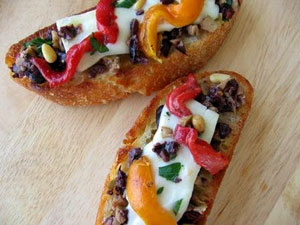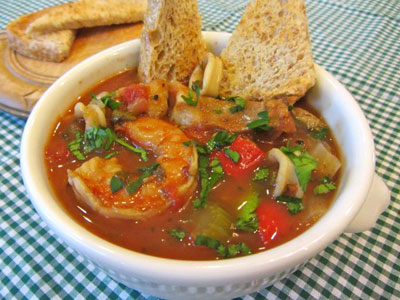 With the blustery weather the Northern hemisphere is having right now, there are plenty of reasons to stay in and gather with family over holiday food. And for safety's sake, I just hope that is what most people are doing. There are many dishes that create a sense of togetherness, but none is as famous as fondue. This dish of melted cheese originates from the Alps. The Swiss popularized and designated it a national dish in the 1930s. It eventually crossed the pond and became extremely popular in suburban America during the 1960s. There are also French and Italian versions, like Fonduta, as it's called in Italy.
With the blustery weather the Northern hemisphere is having right now, there are plenty of reasons to stay in and gather with family over holiday food. And for safety's sake, I just hope that is what most people are doing. There are many dishes that create a sense of togetherness, but none is as famous as fondue. This dish of melted cheese originates from the Alps. The Swiss popularized and designated it a national dish in the 1930s. It eventually crossed the pond and became extremely popular in suburban America during the 1960s. There are also French and Italian versions, like Fonduta, as it's called in Italy.
Fonduta is a specialty of Piedmont and Valle d’Aosta. It is made with fontina, a young cow's milk cheese that melts much like mozzarella. Its taste is similar to other Alpine cheeses, like Gruyère and Emmental from Switzerland. The big difference between Swiss fondue and fonduta is that the Italian recipe does not include wine, garlic, or cornstarch as thickener. Instead fonduta is made with butter, milk, and egg yolks as thickener. It comes together much like custard and is made in a bain-marie, a double boiler. The final dish is richly flavored and silken. It's ideal for a communal gathering of family or a New Year's Eve party with friends. Just add a roaring fire, and complete the Alpine feel.
Retro Recipes and Traditional Fare
Retro Recipes and Traditional Fare
What's the Difference Between Bruschetta and Crostini?
 Bruschetta and crostini? What's the difference?
Bruschetta and crostini? What's the difference?
They’re both wildly popular, easy-to-make Italian appetizers of toasted bread with toppings.
In my family, bruschetta was toasted bread rubbed with garlic and topped with olive oil, tomatoes, and basil, while smaller slices of toasted bread with various toppings were called crostini.
I wanted to provide you with a more thorough explanation of the difference between the two, so I explained to Jeff that we needed to take a trip to Italy to conduct research for my blog. However, out plans fell through. So instead I just Googled it.
Brushcetta, from the Italian "bruscare," which means "to roast over coals," refers to the bread, not the toppings. Rather large slices of bread are grilled, rubbed with garlic, then drizzled with olive oil. They are usually topped with tomatoes and basil, though other toppings from meats to vegetables can be used.
San Francisco Cioppino
 Whether or not you’re trying to lose weight, here’s a hearty but superhealthy one pot dish that’s perfect on a cold night: Skinny San Francisco Cioppino.
Whether or not you’re trying to lose weight, here’s a hearty but superhealthy one pot dish that’s perfect on a cold night: Skinny San Francisco Cioppino.
An iconic seafood stew that evolved in the late 19th century when Italian and Portuguese fisherman ruled the bays of San Francisco and Monterrey, some say its name originated from “Ciuppin,” the Genoese word for fish stew. Other folklore holds that it came from the heavily accented fishermen who called out to one another to “chip in” to the communal stew pot any leftover scraps from the day’s catch.
But wherever the name came from, the basic recipe is always the same: any combination of fresh fish and shellfish–like calamari, cod, halibut, sardines, crabs, clams, mussels and/or shrimp–cooked in a flavorful broth made of fish heads, herbs, onions, tomatoes, fennel and wine, sherry or vermouth.
In this version, all the flavorful veggies, herbs, spices and vermouth are there…but since no one (sadly) boils their own fish heads anymore, I’ve called for good quality seafood broth or chicken broth mixed with anchovy paste, instead. And by bumping up the ratio of vegetables to seafood, the result is lower in calories but just as satisfying as the original…which means you can afford to have a slender slice of toasted sourdough bread with it as well.
So if you’re looking for a taste of the bay area without making a trip, pour a glass of red wine, put on a little Tony Bennett and try this!
Split Pea Soup
 The day after Easter I always find myself with a huge pot of leftover ham stock. In my family we traditionally eat boiled ham and eggs for the holiday. It's a very simple meal that I look forward to every year. I love hard-boiled eggs, so Easter has always been a favorite time of year, because I get to eat all the foods I love, including chocolate. But what to do with all the leftover ham stock? My mom typically makes ham and bean soup, but in the past few years I've started my own tradition of making ham and split pea soup.
The day after Easter I always find myself with a huge pot of leftover ham stock. In my family we traditionally eat boiled ham and eggs for the holiday. It's a very simple meal that I look forward to every year. I love hard-boiled eggs, so Easter has always been a favorite time of year, because I get to eat all the foods I love, including chocolate. But what to do with all the leftover ham stock? My mom typically makes ham and bean soup, but in the past few years I've started my own tradition of making ham and split pea soup.
Since we're already enjoying spring with the suddenly warm weather, it might seem out of place to be making soup. But actually this in-between brisk weather has me craving a soup like this. Fresh peas will be in season soon, but until then split peas are a wonderful substitute. The ham stock is immensely flavorful and works well in this soup. You could also use chicken or vegetable stock. If you have leftover ham, cube it and add it to the soup near the end of cooking time.
Enjoy this Easter leftover soup!
Italian Chocolate-Orange Ricotta Pie
 The days before Easter Sunday are hellish for supermarket workers in Italian-American cities such as Chicago, Philadelphia, and Providence. That's because every Italian woman, whether practicing Catholic or not, will be storming her local supermarket to purchase an obscene amount of eggs. (My mom used to buy between 12-15 dozen every year.) Lord help the poor dairy manager who runs out of eggs.
The days before Easter Sunday are hellish for supermarket workers in Italian-American cities such as Chicago, Philadelphia, and Providence. That's because every Italian woman, whether practicing Catholic or not, will be storming her local supermarket to purchase an obscene amount of eggs. (My mom used to buy between 12-15 dozen every year.) Lord help the poor dairy manager who runs out of eggs.
It's a sight to see. A gaggle of women trying to box one another one, in an effort to select the best eggs. It's the older Italian ladies who are most successful; they have honed their skills over the years. After all, they need to stockpile eggs. How else will they make deviled eggs, braided sweet bread, sausage bread, and a host of pies?
Every Italian Easter table will have one or two savory pies, such as pizza chena (meaning "full pie"), a massive two-crusted pie filled with eggs and various Italian meats and cheeses and pastiera Neopoletana, a time-intensive pie made from ricotta cheese and soaked wheat kernels. The jewels of the Italian Easter table, however, are the sweet pies, namely custard, ricotta, and rice. Custard pie should be dense, creamy, and mile-high. Italian ricotta pie (torta di ricotta), an Italian cheesecake closely associated with Easter, is typically laced with citrus flavors but can also be made with nuts and/or chocolate.
More Articles ...
Welcome to the new One for the Table ...
Our Home Page will be different each time you arrive.
We're sure you'll find something to pique your interest...
